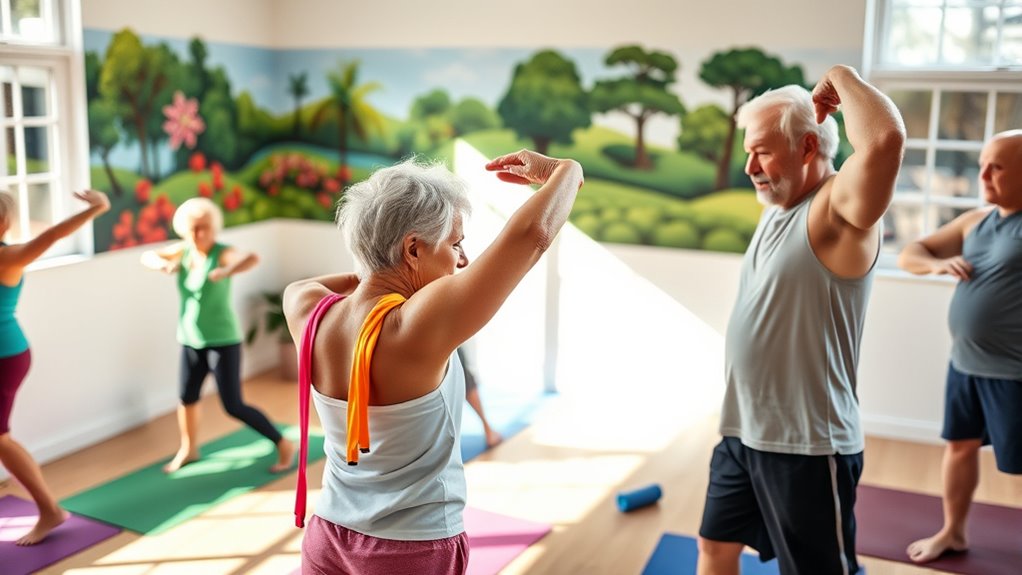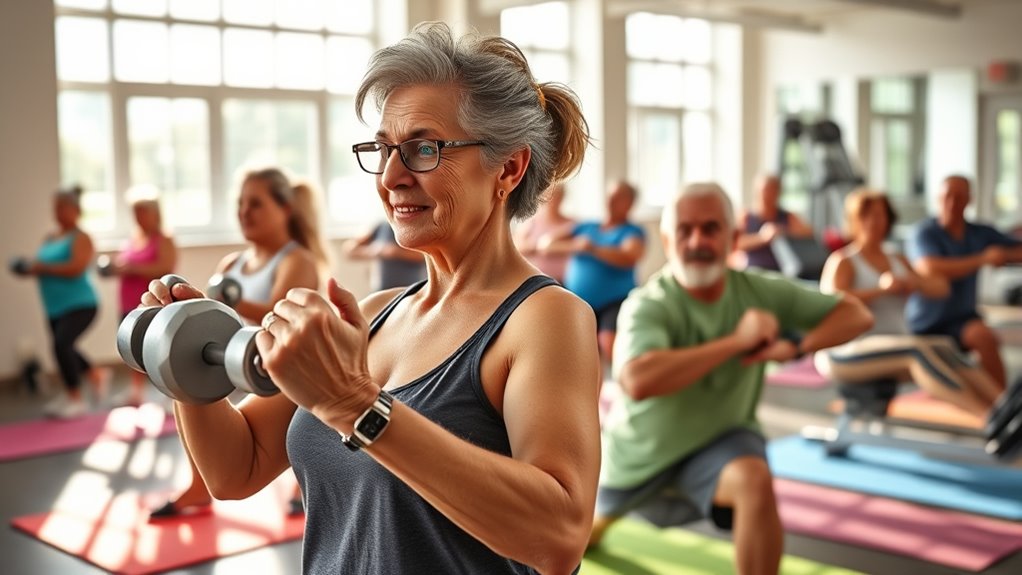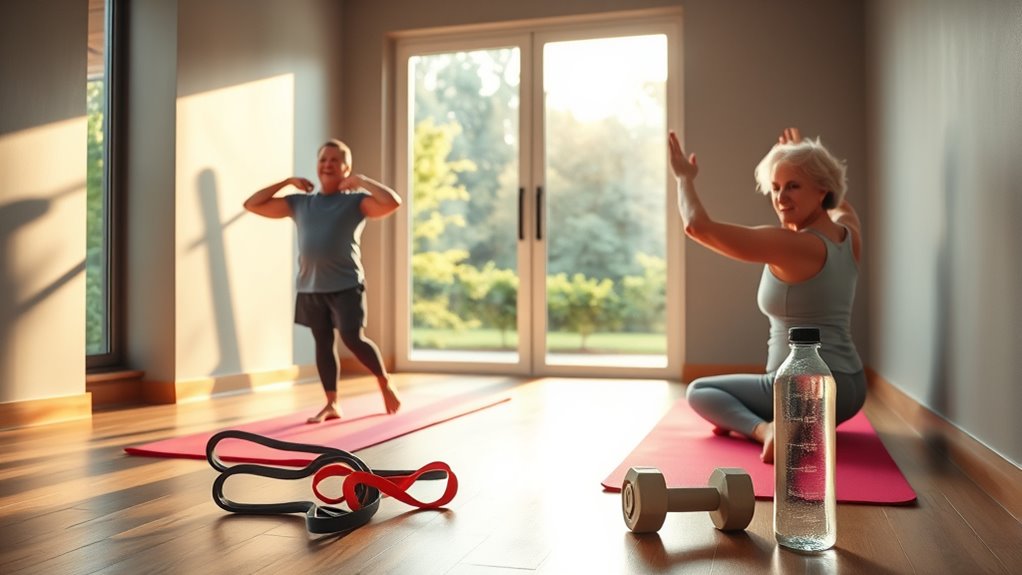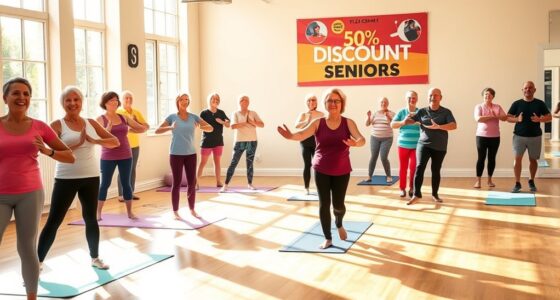Weight training is essential for seniors to maintain strength and mobility. It enhances muscle mass, boosts bone density, and improves mental health. Before starting, consult a healthcare provider and modify exercises to fit your abilities. You’ll need basic equipment like dumbbells and resistance bands. Warm-ups and cool-downs are critical to prevent injury. Regularly tracking progress can keep you motivated. There’s so much more to explore about workouts designed for your needs and ways to stay powerful.
Key Takeaways
- Establish a weekly routine, targeting different muscle groups: chest and triceps, back and biceps, legs, and shoulders for balanced strength development.
- Begin with light weights or resistance bands, gradually increasing weight by 5-10% as strength improves and proper form is maintained.
- Include a warm-up routine with light cardio and mobility exercises to prepare the body and reduce injury risk before strength training.
- Incorporate cool down and stretching post-workout to promote flexibility, blood circulation, and prevent muscle stiffness.
- Utilize resources like SilverSneakers and fitness apps to access tailored workouts and track progress effectively over time.
The Importance of Weight Training for Seniors

As you age, maintaining your strength becomes essential for your independence and overall well-being.
Weight training plays an important role in enhancing muscle mass, helping to combat age-related muscle loss or sarcopenia. By engaging in regular physical activity, you can also improve your bone density, greatly reducing the risk of osteoporosis and fractures. Additionally, studies show that AI technologies can help track your progress in strength training, making it easier to stay motivated and on target. Participating in various exercise routines can also provide variety and keep your workouts engaging. Moreover, incorporating digital literacy programs can enhance your understanding of fitness apps and tools that support your training journey. Furthermore, engaging in regular exercise can help protect your energy and improve your mental resilience, leading to a more fulfilling lifestyle.
Weight training is vital for increasing muscle mass and improving bone density, helping to prevent age-related issues like sarcopenia and osteoporosis.
Plus, weight training boosts your mental health by alleviating symptoms of depression and anxiety, while enhancing cognitive function. Additionally, regular exercise can help mitigate brain fog effects, which may be linked to cognitive decline in older adults.
Consistent strength training improves your balance and coordination, which is critical for lowering the risk of falls—one of the leading causes of injury in older adults.
Embracing weight training not only supports your physical health but also contributes to a more active, independent lifestyle.
Safety Precautions Before Starting

Before diving into weight training, it is crucial to prioritize your safety to guarantee a positive experience. Start by consulting with a healthcare provider to assess your health and any pre-existing conditions. They can help you modify exercises to fit your personal ability and enhance your safety. Additionally, understanding the tax implications of your retirement income can alleviate financial stress, allowing for a more focused approach to your fitness routine. Proper planning regarding your retirement savings can help ensure you have the necessary funds to support your health and fitness goals in the long run, especially when considering RMDs as you age. It is also important to recognize the potential emotional impact that physical activity can have on your overall well-being. Engaging in regular physical activity can also enhance your emotional availability and overall mood, contributing positively to your life after significant changes.
Ensure your workout space is free of obstacles to minimize risk and prevent falls. Always listen to your body; if you feel pain or discomfort, stop immediately. Use a yoga mat for floor exercises to provide comfort during workouts, and avoid overexertion by staying within a manageable limit. Additionally, incorporating self-reflection into your routine can help you identify your limits and adjust your workouts accordingly.
| Safety Precautions | Actions to Take | Benefits |
|---|---|---|
| Consult healthcare provider | Assess health conditions | Tailored exercise plans |
| Modify exercises | Adjust for personal ability | Enhanced safety |
| Clear obstacles | Remove tripping hazards | Minimized risk of injury |
| Listen to your body | Stop if pain occurs | Prevent injury |
| Use supportive gear | Employ yoga mats | Increased comfort |
Essential Equipment for Strength Training

Here are some essential items to evaluate:
- Dumbbells: Start with weights between 3 to 5 pounds, increasing to 8 to 10 pounds as you gain strength. Using higher weights can further enhance muscle engagement and overall strength. Additionally, regular soil moisture checks can ensure your indoor plants thrive while you focus on your fitness routine. It’s important to also focus on self-improvement to maximize the benefits of your strength training routine. Regular exercise, including strength training, is crucial for maintaining overall pet health in aging dogs, which can parallel the benefits for seniors.
- Resistance bands: These offer a versatile alternative, targeting various muscle groups and are easy to store.
- Adjustable dumbbells: A practical investment that lets you change weights easily as your fitness level progresses.
- Household items: Water bottles or soup cans can also serve as effective substitutes for weights, making strength training accessible.
Incorporating these tools into your exercise routine can enhance your strength training efforts and keep you strong and active. Additionally, combining strength training with a diet rich in omega-3 content can further support muscle health and recovery.
Warm-Up Routine for Seniors

A 5-minute warm-up routine is essential for seniors to prepare their bodies for exercise effectively.
Start by jogging in place or marching with high knees to gradually increase your heart rate. Incorporate gentle arm punches to enhance your mobility and engage your core. Engaging in a warm-up is crucial for personal and community resilience as it helps seniors maintain their strength and health. Additionally, a consistent warm-up can improve credit score as seniors who stay active often have better financial health due to lower medical costs. Basic squats are also important; they promote lower body strength and improve balance, reducing your fall risk. Including protein-rich breakfasts can further support energy levels during workouts. Newborn bath tubs can provide a safe and comfortable environment for seniors who may need assistance during their exercises. Shift smoothly between these exercises with minimal rest to keep that heart rate elevated.
If you’re doing floor exercises, use a yoga mat for added cushioning and safety.
This warm-up routine not only prepares your body for strength training but also sets the tone for a safe and productive workout session. Additionally, maintaining proper installation practices can significantly reduce the risk of mechanical failures during your fitness journey.
Key Strength Training Exercises

After your warm-up, it’s time to focus on key strength training exercises that can greatly benefit seniors.
These exercises enhance muscle strength and improve functionality for daily activities, ensuring you maintain independence. Additionally, engaging in regular exercise can support kidney health maintenance, as physical activity plays a crucial role in overall wellness. Regular physical activity can also improve mental clarity and cognitive function, which is vital for maintaining overall health as you age. Moreover, consistent strength training can lead to improved audiometric testing outcomes, helping to identify any potential hearing issues early on.
Here are some vital exercises for seniors:
- Squats: Strengthen your legs and core, mimicking real-life movements.
- Lunges: Improve balance and stability while building muscle in your lower body.
- Seated Row: Targets upper body strength, promoting better posture and functionality.
- Overhead Press: Develops shoulder strength, essential for preventing balance issues.
Incorporating these functional movements into your routine will enhance your overall physical health! Additionally, engaging in regular exercise can positively influence your mental wellbeing index, encouraging a holistic approach to health.
Remember to always use proper form to maximize benefits and reduce injury risk.
Sample Weight Training Routine

When planning your weight training routine, it’s important to structure your week effectively and include essential exercises that target major muscle groups.
You should focus on progression by starting with bodyweight movements and gradually adding resistance as you gain strength.
Let’s look at a sample routine to help you get started and stay safe while training.
Weekly Routine Structure
To maintain a balanced and effective weight training routine, seniors should follow a structured weekly schedule that targets different muscle groups each session. This helps enhance strength training and guarantees proper recovery time.
Here’s a sample weekly routine structure:
- Monday: Chest and triceps (3-4 sets of 10-15 repetitions)
- Tuesday: Back and biceps (3-4 sets of 10-15 repetitions)
- Thursday: Legs (3-4 sets of 10-15 repetitions)
- Friday: Shoulders (3-4 sets of 10-15 repetitions)
Incorporate rest days on Wednesdays, Saturdays, and Sundays to allow for muscle recovery.
Start with light weights to focus on proper form, and aim for at least two to three sessions weekly. This approach will boost bone density and functional fitness, leading to a healthier, more active lifestyle.
Essential Exercises Overview
Building on the structured weekly routine, a well-rounded sample weight training routine focuses on key exercises that enhance strength and functional fitness for seniors.
Incorporate essential exercises like squats, incline push-ups, and seated rows to target major muscle groups—legs, chest, back, and arms. Aim for 3 sets of 10-15 repetitions for each exercise to build muscle and improve overall mobility.
By focusing on these bodyweight exercises, you not only promote balanced muscle development but also reduce the risk of injury. Schedule strength training sessions on at least two non-consecutive days each week, allowing rest days in between for muscle recovery.
Gradually increase weights as you progress, ensuring you maintain proper form to maximize benefits.
Tips for Progression
Progressing in your weight training routine is essential for continued strength gains and overall fitness. To guarantee you’re on the right track, keep these tips in mind:
- Start with light weights to master proper form and reduce the risk of injury.
- Gradually increase the weight by 5-10% once you can comfortably complete 12-15 repetitions without strain.
- Aim for at least two to three strength training sessions per week, allowing for a day of rest between sessions to promote recovery.
- Track your progress by recording the weights used and repetitions completed to set realistic goals.
Incorporate variety in your routine to target different muscle groups, guaranteeing balanced development and preventing overuse injuries.
Stay consistent, and you’ll see improvements!
Progressing With Your Workouts

As you become more comfortable with your weight training routine, it’s important to gradually increase the weights or resistance to continue making progress.
A good rule of thumb is to increase weights once you can comfortably complete 15 repetitions with proper form. Incorporating variety in your routine, like switching exercises or using resistance bands, helps prevent plateaus and keeps workouts engaging.
To track your progress, maintain a workout journal that highlights your strength gains and motivates you to push forward.
Remember to allow adequate recovery time between strength training sessions, as muscle soreness may take longer to resolve with age.
Typically, aim for 48 hours of recovery for ideal results and to stay powerful in your fitness journey.
Cool Down and Stretching

After your workout, taking time to cool down is essential for bringing your heart rate back to normal and preventing dizziness.
Incorporating effective stretching techniques can boost your flexibility and aid in recovery, helping you feel better overall.
Importance of Cooling Down
Cooling down is essential for your post-workout routine, especially as you age. It helps lower your heart rate and normalize your breathing, allowing for a smooth shift from exercise to rest.
Engaging in a cool-down routine can enhance your recovery and promote overall physical well-being. Here are some benefits of cooling down:
- Improves blood circulation to the muscles
- Supports flexibility and reduces muscle tension
- Aids in injury prevention, particularly important for seniors
- Minimizes the risk of soreness and stiffness
Taking just five minutes for cooling down activities guarantees your body relaxes and recovers effectively.
Prioritizing this phase of your workout can lead to better long-term results and healthier aging.
Effective Stretching Techniques
To enhance your recovery and maintain flexibility, effective stretching techniques should be a key part of your cool-down routine.
Cooling down for at least five minutes helps lower your heart rate and normalize breathing, essential for recovery.
After strength training, engage in gentle full-body stretches to relax your muscles and boost flexibility, reducing soreness.
Focus on major muscle groups like hamstrings, quadriceps, shoulders, and back to promote mobility and maintain a full range of motion as you age.
These gentle stretches not only improve muscle recovery but also contribute to long-term joint health, minimizing the risk of injuries.
Consistent stretching practices will keep you feeling powerful and ready for your next workout!
Flexibility and Mobility Benefits
While many people overlook the importance of flexibility and mobility, they play a crucial role in your overall fitness, especially as you age.
Incorporating cool-down and stretching routines after your strength training can greatly enhance these aspects, promoting a healthier lifestyle.
Here are some key benefits:
- Increases flexibility, improving your range of motion
- Enhances balance and stability, reducing the risk of injury
- Aids in recovery, helping you bounce back faster from workouts
- Supports your independence by making daily activities easier
Tracking Your Progress

Tracking your progress in weight training is essential, especially as you age, since it helps you stay motivated and committed to your fitness journey.
Keeping a workout journal can be a game changer; jot down weights lifted, repetitions, and sets completed during your workouts. Setting specific, measurable goals—like increasing the weight lifted by 5% each month—keeps you focused.
Regularly measuring body composition changes offers tangible proof of your progress, reinforcing your commitment to strength training. Consider using fitness apps to log workouts and monitor performance trends, making it easier to adjust your routines.
Additionally, evaluating functional fitness with activities like timed sit-to-stand tests helps you gauge improvements in strength and mobility, ensuring your resistance training is truly effective.
Resources for Further Learning

Understanding how to track your progress is just the beginning of your fitness journey. To enhance your strength training routine and gain more insights, consider these valuable resources tailored for older adults:
- SilverSneakers: Offers on-demand workout videos and health tips specifically designed for seniors to safely engage in training exercises.
- CDC Guidelines: Provides extensive advice on physical activity, emphasizing the role of strength training in your exercise program.
- Local Community Centers: Many offer specialized programs focusing on bodyweight lunges and functional fitness to improve muscle strength and stability and balance.
- Fitness Apps: Look for those geared towards older adults, helping you monitor your workouts and track improvements in physical appearance and overall health.
Stay informed and keep progressing!
Frequently Asked Questions
What Is the Best Weight Lifting Routine for Seniors?
To find the best weight lifting routine, focus on exercises that engage major muscle groups.
You should aim for light to moderate weights, performing 8 to 12 repetitions for 2 to 3 sets.
Incorporate functional movements like squats and lunges to enhance your strength and stability.
Always prioritize proper form over heavier weights to prevent injuries.
Consulting a fitness professional can help you tailor your routine to match your individual needs and goals.
What Is the 6 12 25 Rule?
The 6 12 25 Rule is a strength training method that combines three distinct repetition ranges.
You lift heavier weights for six reps to build strength, switch to moderate weights for twelve reps to enhance endurance, and finish with lighter weights for twenty-five reps to maximize muscle stamina.
This approach not only targets different muscle fibers but also helps you improve overall fitness, ensuring a balanced and effective workout that’s adaptable to your capabilities.
How Many Times a Week Should a Senior Lift Weights?
You should aim to lift weights at least twice a week to maintain and improve your muscle strength.
Each session should target major muscle groups, ensuring you work your body evenly.
Start with shorter workouts of about 10 to 15 minutes if you’re new to weight training, gradually increasing the time and intensity as you get stronger.
How Can a 70 Year Old Get Stronger?
At 70, think of your body as a classic car—you can keep it running smoothly with the right maintenance.
You can get stronger by engaging in strength training at least twice a week. Start with bodyweight exercises like squats and push-ups to build a solid foundation.
Gradually add light weights or resistance bands as you progress. Just 10 to 15 minutes a day can rev up your strength and enhance your overall mobility.
Conclusion
Don’t let age hold you back from feeling strong and vibrant! You might think weight training is too risky, but with the right precautions, it can actually boost your confidence and improve your quality of life. Imagine lifting your grandkids with ease or tackling daily tasks effortlessly. Embrace the journey of strength training and discover the empowering changes it brings. You deserve to feel powerful and capable at any age—so start today and release your full potential!










